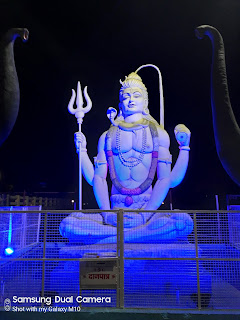Why do we put sindoor on Hanuman idols?
There is a very interesting Puranic story about it. Once Sita was applying vermilion (sindoor) on her forehead, Hanuman asked her why she was doing that. Sita replied that it would ensure the long life of her husband Rama. The next day, Hanuman came to the court of Rama, painted himself with vermilion (sindoor) pasted all over his body. Everybody laughed at him. Rama asked him about it. Hanuman replied that if the vermilion painted on the forehead of mother Sita could increase the life of Rama, painting all over his body might make him immortal. This is the story of his intense love and reverence for his master Rama.
This is the matter of Puran. But there is another aspect which is described in the epic Mahabharata by Vyas. When the army of Sugreev was preparing for battle, the soldiers were applying red paste and the soldiers of Jamvant were applying black paste over their body.
गिरिकूटनिभाः के चित्के चिन्महिषसंनिभाः
शरदभृप्रतीकाशाः पिष्टहिंगुलकाननाः
Mahabharata- 3:267:11
"Some looking like mountain peaks, some like buffalo, like autumn clouds or having their forces smeared with vermilion paste."
That was a tradition or a method of recognition in the battlefield. Hanuman was a general of Sugreev's army, he used to apply red vermilion paste all over his body. It may be the second explanation.
Around first century AD, Jain poet Vimalasuri described in his book 'Paumacaria- the life of Padma (Rama)' that the soldiers of Sugreev and Jamvant were not monkeys and bears but humans. The national emblem of Sugreev's army was 'monkey' and it was painted on his flags, banners and crowns. Their soldiers were called themselves monkeys.
Paumacaria- 6.86-90.
John E. Cart opined that Vimalasuri assessed the more common version of Ramayana story prevalent in the songs of ballads.
ref:- John E. Cart- An overview of Jain Puranas in Doniger, Wendy ed. Purana perennis- Reciprocity and Transformation in Hindu and Jaina Texts, Shri Satguru Pub. 1991, p.- 190.
Whatever may be the reason, there is a strong belief and reverence of Indian people in the worship of vermilion painted lord Hanuman.











Comments
Post a Comment